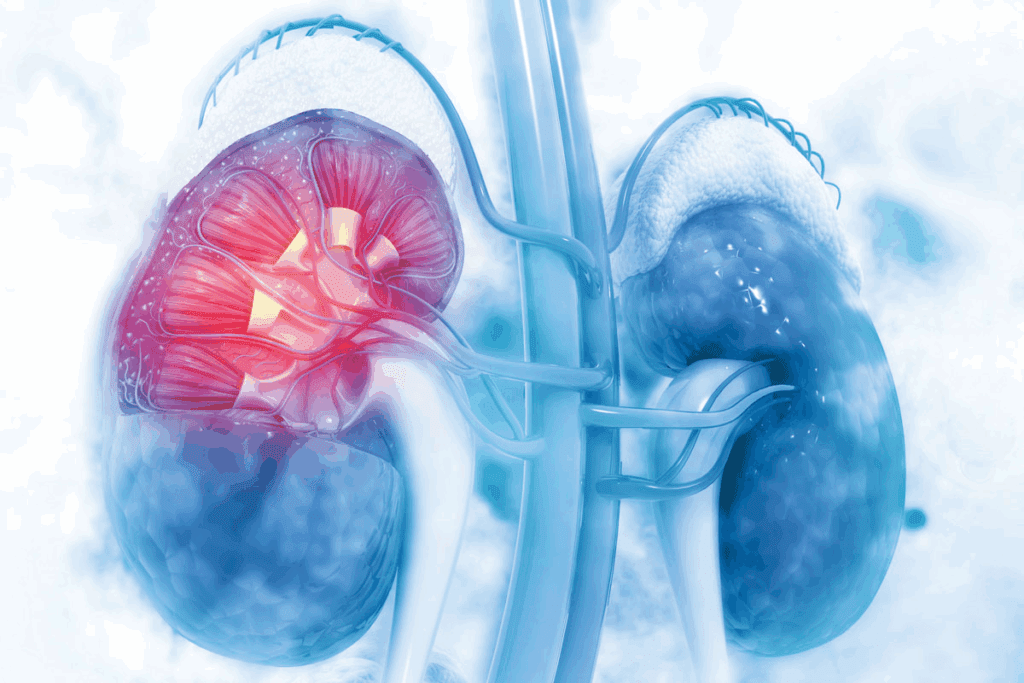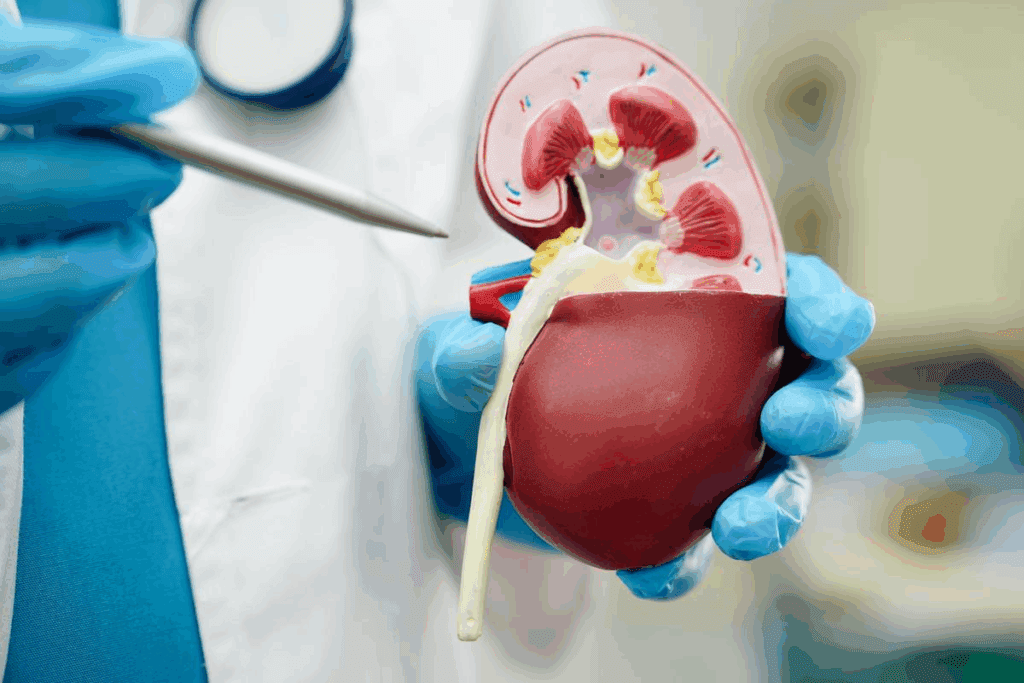Last Updated on November 26, 2025 by Bilal Hasdemir

Getting a kidney cancer diagnosis can feel scary. But knowing your treatment options is key to making smart choices about your health. What are the treatment options for kidney cancer? Our 2025 guide covers 7 powerful choices, from surgery to immunotherapy.
At Liv Hospital, our team is all about patient-centered care. We use the newest kidney neoplasm treatment methods. This includes surgery, targeted therapies, immunotherapy, and new cancer vaccines. We aim to give patients hope and the latest care options.
New studies and trials are showing great promise in kidney cancer treatment. Combination therapies and new targeted agents are opening up new paths for patients. Our kidney cancer doctor works with each patient to find the best treatment plan.
Key Takeaways
- Advanced kidney cancer treatment options are available in 2025, including surgery, targeted therapies, and immunotherapy.
- Kidney neoplasm treatment is evolving with emerging cancer vaccines and combination therapies.
- A kidney cancer doctor can help determine the most effective treatment plan for each patient.
- Patient-centered care is key for delivering hope and advanced solutions for kidney cancer patients.
- Liv Hospital is dedicated to top-notch healthcare with full international patient support and guidance.
Understanding Kidney Cancer in 2025

Kidney cancer in 2025 is complex, with many types and stages. Each stage affects the treatment plan. It’s important to know that kidney cancer is not just one disease. It’s a group of tumors in the kidney.
Types and Stages of Kidney Cancer
Kidney cancer is divided into types based on cell origin and characteristics. The most common is clear cell renal cell carcinoma (ccRCC), making up 70-80% of cases. Other types include papillary, chromophobe, and collecting duct carcinoma. Knowing the stage of kidney cancer is key, as it shows how far the disease has spread.
The TNM system is used to stage kidney cancer. It looks at the tumor size (T), nearby lymph nodes (N), and distant metastasis (M). Stage I means a small tumor in the kidney, while Stage IV means it has spread far.
Recent Advances in Diagnosis
Diagnosing kidney cancer has improved a lot in recent years. Biomarkers like KIM-1 and circulating tumor DNA help predict treatment success and track disease growth.
Imaging techniques have also improved. Multiphasic contrast-enhanced CT scans and MRI give detailed tumor information. This helps in staging and treatment planning.
Biopsy is also important for diagnosis. It was used less before due to concerns about spreading the tumor. But new biopsy methods make it safer and more reliable, helping in uncertain cases.
Surgical Approaches for Kidney Cancer

Surgery is a main treatment for kidney cancer. It offers different methods based on the patient’s needs. The choice of surgery depends on the cancer’s stage, type, and the patient’s health.
Radical Nephrectomy
Radical nephrectomy removes the whole kidney, tumor, adrenal gland, and nearby tissues. It’s often chosen for big tumors or those that spread. Thanks to new surgical methods, this procedure is now safer and more effective.
Partial Nephrectomy
Partial nephrectomy removes the tumor but keeps most of the kidney. It’s good for small tumors or those at risk of kidney failure. Keeping the kidney working well is key, and this surgery helps a lot.
Minimally Invasive Surgical Techniques
Techniques like laparoscopic and robotic-assisted surgery are becoming popular. They offer smaller cuts, less pain, and faster healing. They are used for both radical and partial nephrectomies.
- Less blood loss
- Less pain after surgery
- Shorter hospital stays
- Quicker return to daily activities
We choose the best surgery for each patient. This way, we can improve their life and treatment results.
Ablative Therapies for Small Kidney Tumors
For those with small kidney tumors, ablative therapies are a good choice. They are less invasive than surgery. Treatments like radiofrequency ablation, cryoablation, and microwave ablation are used more often.
Radiofrequency Ablation
Radiofrequency ablation (RFA) uses heat to kill cancer cells. RFA is done under imaging guidance for precise targeting. It’s great for small tumors that are hard to reach surgically.
Cryoablation
Cryoablation freezes cancer cells to death. It’s also guided by imaging to target the tumor well. Cryoablation works well for small tumors with little harm to healthy tissue.
Microwave Ablation
Microwave ablation (MWA) heats and kills cancer cells with microwave energy. MWA is a quick, less invasive option for small tumors. It has shorter procedure times and fewer complications than surgery.
Ablative therapies have many benefits. They reduce recovery time, cause less pain, and leave little to no scar. But, like any treatment, there are risks to think about. Here’s a comparison of the different ablative therapies in a table below.
| Therapy | Mechanism | Benefits |
| Radiofrequency Ablation | Heat generated by electrical currents | Precise targeting, minimal damage |
| Cryoablation | Extreme cold to freeze cancer cells | Effective, minimal damage to healthy tissue |
| Microwave Ablation | Microwave energy to heat cancer cells | Shorter procedure times, fewer complications |
“Ablative therapies represent a significant advancement in the treatment of small kidney tumors, providing patients a less invasive alternative to traditional surgery.”
Expert Opinion
In conclusion, ablative therapies are a good option for small kidney tumors. They offer a less invasive choice with fewer complications. We keep up with new research to give our patients the best care.
Targeted Therapy Options for Kidney Cancer
Targeted therapy has changed the game for kidney cancer treatment. It brings new hope to patients. We’ve seen big steps forward, with therapies like VEGF and mTOR inhibitors working well.
These therapies target cancer cells directly, protecting healthy cells. Immunotherapy is also showing promise, boosting the body’s fight against cancer.
Studies have shown that combining therapies like lenvatinib and everolimus can lead to better results. We’re always looking for new ways to treat kidney cancer, mixing targeted and immunotherapy approaches.
Looking ahead, targeted therapy will keep being a key part of treating kidney cancer. It offers patients more effective and tailored treatments.
FAQ
What are the main treatment options for kidney cancer?
Treatments for kidney cancer include surgery, targeted therapies, and immunotherapy. Cancer vaccines are also being explored. The right treatment depends on the cancer’s type and stage, and the patient’s health.
How is kidney cancer diagnosed?
Doctors use CT scans and MRI to find kidney cancer. They also do biopsies. New tests like KIM-1 and circulating tumor DNA help predict how well treatments will work.
What are the different types of surgical approaches for kidney cancer?
Surgical options include radical nephrectomy and partial nephrectomy. Minimally invasive methods are also used. The choice depends on the tumor’s size and location, and the patient’s health.
What are ablative therapies, and how are they used to treat kidney cancer?
Ablative therapies like radiofrequency ablation destroy small tumors. They are used when surgery is not an option. These treatments are minimally invasive.
What are targeted therapies, and how do they work in treating kidney cancer?
Targeted therapies target specific molecules in cancer cells. They slow or stop tumor growth. Treatments like VEGF inhibitors and mTOR inhibitors are examples.
What are the benefits and risks of targeted therapy for kidney cancer?
Targeted therapy can improve treatment outcomes and reduce side effects. But, it can also cause side effects like fatigue and diarrhea.
How do combination regimens, such as lenvatinib plus everolimus, work in treating kidney cancer?
Combination regimens target multiple pathways in cancer cells. This can lead to better treatment outcomes and lower resistance to treatment.
What is the role of a kidney cancer doctor in managing kidney cancer?
A kidney cancer doctor helps by guiding treatment choices and creating personalized plans. They also monitor how well treatments are working.
Are there any alternative treatments available for kidney cancer?
Alternative treatments are sometimes considered. But, it’s important to talk to a kidney cancer doctor to ensure they are safe and effective.
What are the future directions in kidney cancer treatment?
Future treatments include new targeted therapies, immunotherapies, and vaccines. Advances in surgery and ablative therapies are also expected.






